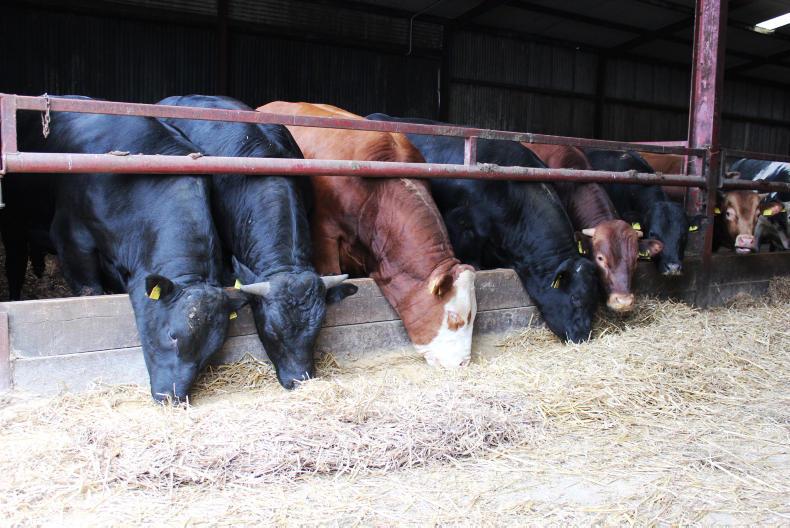Spring-born bulls that are destined for slaughter in the coming months should be weighing close to 550kg liveweight by the end of January, if animals are to reach a final liveweight of 650kg to 680kg when slaughtered in May.
At the outlined target liveweight, young bulls will produce a carcase weight of 370kg to 395kg at 58% kill-out.
Bulls will now be moving into the final finishing phase, where the focus should be to get fat cover on animals
Higher kill-out percentages will produce carcase weights well over 400kg, so talk to your factory agent to see if they are willing to take bulls at this weight. If not, feeding needs to be tailored to get bulls killed earlier at a suitable weight.
Bulls will now be moving into the final finishing phase, where the focus should be to get fat cover on animals. The growing phase should now be over.
Maize
During the final finishing phase, concentrates should be higher in energy and low in protein. Use a ration that is high in cereals, ideally with 50% maize content, to increase energy and starch content to encourage bulls lay down fat.
Keep protein content to 12% to 13% maximum. Higher-protein rations will keep bulls laying down lean muscle, meaning bulls will struggle to reach fat class 3.
Fibre
Where bulls are being offered a ration with a high cereal content, make sure animals have plenty of fresh, palatable fodder as a fibre source. This can be either silage or straw.
Including soya hulls or beet pulp is also a good idea, as they are a good source of energy and also increase fibre levels. Finally, make sure bulls have unlimited access to fresh water.
Phased change
When changing ration type, it should be phased in. Start by offering 25% of the finishing ration and 75% of the growing ration, then increase to 50:50 after three days, increase to 75:25 after another three days, then finally move on to 100% of the finishing ration.
Read more
Newford update: full analysis of 2019 slaughter performance
Five tips when planning spring fertiliser
Spring-born bulls that are destined for slaughter in the coming months should be weighing close to 550kg liveweight by the end of January, if animals are to reach a final liveweight of 650kg to 680kg when slaughtered in May.
At the outlined target liveweight, young bulls will produce a carcase weight of 370kg to 395kg at 58% kill-out.
Bulls will now be moving into the final finishing phase, where the focus should be to get fat cover on animals
Higher kill-out percentages will produce carcase weights well over 400kg, so talk to your factory agent to see if they are willing to take bulls at this weight. If not, feeding needs to be tailored to get bulls killed earlier at a suitable weight.
Bulls will now be moving into the final finishing phase, where the focus should be to get fat cover on animals. The growing phase should now be over.
Maize
During the final finishing phase, concentrates should be higher in energy and low in protein. Use a ration that is high in cereals, ideally with 50% maize content, to increase energy and starch content to encourage bulls lay down fat.
Keep protein content to 12% to 13% maximum. Higher-protein rations will keep bulls laying down lean muscle, meaning bulls will struggle to reach fat class 3.
Fibre
Where bulls are being offered a ration with a high cereal content, make sure animals have plenty of fresh, palatable fodder as a fibre source. This can be either silage or straw.
Including soya hulls or beet pulp is also a good idea, as they are a good source of energy and also increase fibre levels. Finally, make sure bulls have unlimited access to fresh water.
Phased change
When changing ration type, it should be phased in. Start by offering 25% of the finishing ration and 75% of the growing ration, then increase to 50:50 after three days, increase to 75:25 after another three days, then finally move on to 100% of the finishing ration.
Read more
Newford update: full analysis of 2019 slaughter performance
Five tips when planning spring fertiliser






 This is a subscriber-only article
This is a subscriber-only article










SHARING OPTIONS: